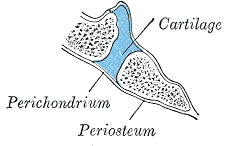Synchondrosis
Type of cartilaginous joint
| Synchondrosis | |
|---|---|
| General Information | |
| Latin | |
| Greek | |
| TA98 | |
| TA2 | |
| FMA | |
| Details | |
| System | |
| Artery | |
| Vein | |
| Nerve | |
| Lymphatic drainage | |
| Precursor | |
| Function | |
| Identifiers | |
| Clinical significance | |
| Notes | |
A synchondrosis is a type of cartilaginous joint where the bones are joined by hyaline cartilage. This type of joint is typically found in the skeletal system and is characterized by its immobility or very limited movement. Synchondroses are important during the growth and development of the skeleton.
Structure
Synchondroses are composed of hyaline cartilage, which is a translucent type of cartilage that provides support and flexibility. This cartilage is found at the ends of long bones, in the rib cage, and in the nose, among other locations. The primary function of hyaline cartilage in synchondroses is to allow for growth and slight movement during the early stages of development.
Examples
One of the most well-known examples of a synchondrosis is the epiphyseal plate (growth plate) found in the long bones of children and adolescents. The epiphyseal plate is responsible for the longitudinal growth of bones. As a person matures, the hyaline cartilage in the epiphyseal plate is gradually replaced by bone, a process known as endochondral ossification, eventually forming a synostosis.
Another example is the joint between the first rib and the manubrium of the sternum. This joint remains a synchondrosis throughout life, providing stability to the thoracic cage.
Function
The primary function of synchondroses is to allow for bone growth and development. During childhood and adolescence, the hyaline cartilage in these joints permits the bones to lengthen and grow. Once growth is complete, many synchondroses ossify and become synostoses, which are bony joints with no movement.
Clinical significance
Disorders of synchondroses can lead to growth abnormalities and skeletal deformities. For example, premature closure of the epiphyseal plate can result in growth disorders such as dwarfism or gigantism, depending on whether the closure occurs too early or too late.
See also
References
Transform your life with W8MD's budget GLP-1 injections from $125.
W8MD offers a medical weight loss program to lose weight in Philadelphia. Our physician-supervised medical weight loss provides:
- Most insurances accepted or discounted self-pay rates. We will obtain insurance prior authorizations if needed.
- Generic GLP1 weight loss injections from $125 for the starting dose.
- Also offer prescription weight loss medications including Phentermine, Qsymia, Diethylpropion, Contrave etc.
NYC weight loss doctor appointments
Start your NYC weight loss journey today at our NYC medical weight loss and Philadelphia medical weight loss clinics.
- Call 718-946-5500 to lose weight in NYC or for medical weight loss in Philadelphia 215-676-2334.
- Tags:NYC medical weight loss, Philadelphia lose weight Zepbound NYC, Budget GLP1 weight loss injections, Wegovy Philadelphia, Wegovy NYC, Philadelphia medical weight loss, Brookly weight loss and Wegovy NYC
|
WikiMD's Wellness Encyclopedia |
| Let Food Be Thy Medicine Medicine Thy Food - Hippocrates |
Medical Disclaimer: WikiMD is not a substitute for professional medical advice. The information on WikiMD is provided as an information resource only, may be incorrect, outdated or misleading, and is not to be used or relied on for any diagnostic or treatment purposes. Please consult your health care provider before making any healthcare decisions or for guidance about a specific medical condition. WikiMD expressly disclaims responsibility, and shall have no liability, for any damages, loss, injury, or liability whatsoever suffered as a result of your reliance on the information contained in this site. By visiting this site you agree to the foregoing terms and conditions, which may from time to time be changed or supplemented by WikiMD. If you do not agree to the foregoing terms and conditions, you should not enter or use this site. See full disclaimer.
Credits:Most images are courtesy of Wikimedia commons, and templates, categories Wikipedia, licensed under CC BY SA or similar.
Contributors: Prab R. Tumpati, MD

